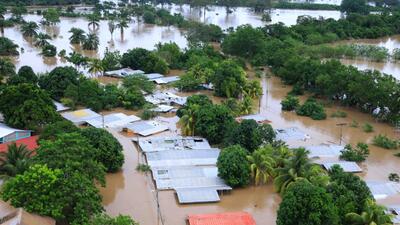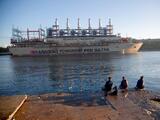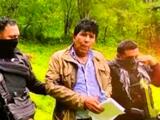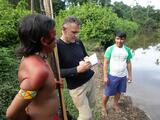"It's all under water..." Hurricane Iota leaves mounting death toll and devastation in Central America

As the skies cleared over Honduras and Nicaragua the death and devastation left behind by Hurricane Iota is beginning to emerge.
But, with large parts of the north of Nicaragua and Honduras still under water, it could be several days before the seriousness of the latest natural disaster to strike Central America is known.
"It's a very hard to take, on top of covid-19 and what Eta destroyed," said Herlan Castellano, a 40-year-old an unemployed seaman who was rescued by dinghy on Wednesday from his flooded home by the Red Cross in the town of La Lima on the outskirts of San Pedro Sula in northern Honduras.
“I had to get out for my life, the river is growing very fast. It doesn't matter if you live on a second or third floor,” he told Univision. “This is getting ugly, but you have to keep going and ask God that everything will fine, added.
On Wednesday, rescue teams found four people, two adults and two children, trapped in their houses by rising flood waters in the colina Buenos Aires in La Lima. “The water is rising faster and faster,” said Ingrid Sanchez, the 25-year-old mother of the two children, aged one and six
Death toll rising
After making landfall as a category 4 hurricane on Monday night off the north coast of Nicaragua, Iota left massive flooding in its wake and at least 45 deaths, as towns and villages were cut off by mudslides that destroyed roads and bridges, leaving leaving them without water or electricity.
For the moment, it appears that Iota has claimed fewer victims than Hurricane Eta, which struck Central America just two weeks ago, leaving thousands homeless and killing 150 people, most of them due to a landslide in Guatemala. Reports of missing people from Eta are still being verified.
Iota's lesser death toll is partly because many people were already in shelters having abandoned their homes after the first storm. But residents told Univision that Iota's flooding was more widespread, reaching areas that had not been flooded before and with even stronger and more dangerous currents in the overflowing rivers.
World Central Kitchen's celebrity chef José Andrés, who is leading the effort to prepare food for the victims, posted a video on Wednesday taken from a helicopter over San Pedro Sula showing a vast flooded landscape.
"It's all under water, it's all under water ...", he said.
Besides wahsing away roads and bridges, Iota destroyed an enormous amount of crops, putting many farmers and their families in danger of a lack of food. “We have seen whole crops and the production of many fruits totally flattened and underwater,” said Andrés. "It is time to take food as a national security issue for each country," he added.
Five miembros of one family, including a four-month-old baby, died in a mudslide in Ocotepeque in the mountains of western Honduras, according to local media reports.
Most of the deaths reported so far were in Nicaragua, including several children; in addition to two others in the Colombian islands of San Andrés, Providencia and Santa Catalina in the Caribbean.
Up to 99.5% of homes in Puerto Cabaezas on Nicaragua's Caribbean coast are without electricity, the country's National System for Disaster Prevention and Attention (Sinapred) said on Tuesday. Four adults and two children died as a result of Iota, said Nicaraguan Vice President Rosario Murillo.
A landslide in northern Nicaragua buried 12 people in the hamlet of La Dalia, according to República 18, an independent digital media outlet in Nicaragua. Four people were rescued but the other eight are feared dead.
The Bishop of Matagalpa, Monsignor Rolando Álvarez, wrote on social media: “Deep sorrow for what has happened to us in the Peñas Blancas Massif, between La Dalia and Rancho Grande. At this time, our priests are mobilizing to that area."
Another landslide was reported near Wiwilí, in northern Nicaragua, where two people died under the mud.
Unprecedented hurricanes
Iota was the second major hurricane to hit the region in two weeks, following a similar path as Eta across Honduras and Nicaragua in what meteorolgists says was an unprecedented back-to-back catastrophe.
The current Atlantic hurricane season has historically been active: Iota brought the number of named storms this year to 30, a record high.
The hurricane affected most of Nicaragua and Honduras, two countries with abundant topography of mountains and rivers. The effects of deforestation in many of its national parks have also left many of these rural communities vulnerable to flash floods and landslides.
Not as bad as Mitch
Despite being closer to the eye of Iota, the situation was much better than had been feared in the Honduran capital, Tegucigalpa, and other towns in the south of the country where Hurricane Mitch caused massive destruction in 1998. That appeared to be largely because of the speed Iota was moving along its westward path and its gradual dissipation into a tropical storm by the time it reached central Honduras, about 250 miles from where it made landfall.
The worst hit areas were in the north of Honduras, the same region that was impacted by Eta, where the northeastern quadrant of Iota, the so-called ‘dirty side’, of the storm usually carries the worst rain and winds.
Video images showed raging rivers of brown, muddy water flowing through the streets of the Rio Negro barrio in the historic colonial town of Trujillo, where Christopher Columbus set foot in 1502.
“It was a ravine that overflowed into that whole area, at the entrance of the town,” Ismael Dubon, a 58-year-old Red Cross volunteer told Univision. About 300 townspeople took refuge in local shelters but fortunately there were no deaths, he said.
“It was just too much with the two weather events like that, one after the other. Eta came and went and the floodwaters were still sitting there, and then Iota came, and everything was flooded again. It's never flooded like that, ever before,” Dubon added.
Dubon said he had put plans to open a small hotel on hold this summer due to the covid-19 outbreak, and now he doesn’t know when the economy will ever recover.
“But the sun is coming out a bit now and the water is receding. We can start cleaning up, again,” he added.



